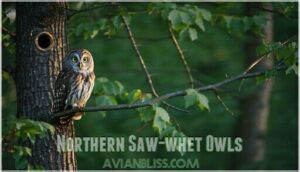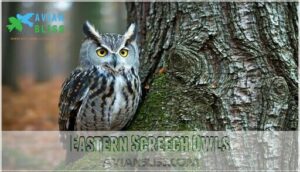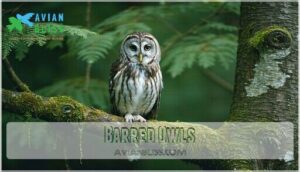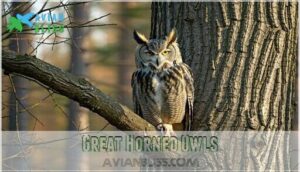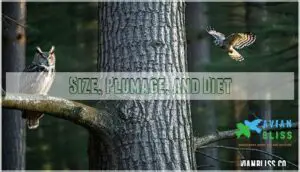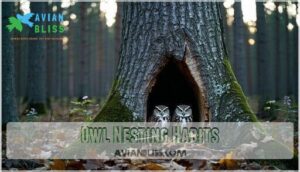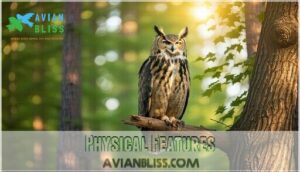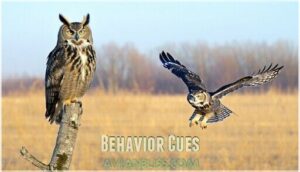This site is supported by our readers. We may earn a commission, at no cost to you, if you purchase through links.
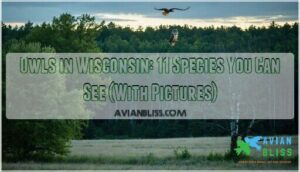
Wisconsin’s diverse landscapes—dense forests, wetlands, and open prairies—create ideal hunting territories for these nocturnal predators.
Listen for the Barred Owl’s distinctive "who-cooks-for-you" call echoing through old-growth woodlands, or catch a Barn Owl’s ghostly silhouette gliding over farmland at dusk.
Each species has adapted to specific habitats across the state, making Wisconsin a premier destination for owl enthusiasts.
From migration patterns to nesting behaviors, these raptors reveal fascinating survival strategies that’ll change how you view nighttime sounds.
Table Of Contents
- Key Takeaways
- Northern Saw-whet Owls
- Eastern Screech Owls
- Barred Owls
- Great Horned Owls
- Owls You Can See in Wisconsin
- Owl Conservation in Wisconsin
- Characteristics and Behavior of Common Wisconsin Owls
- Owl Nesting Habits
- Owl Identification in Wisconsin
- Interactions With Owls in Your Yard
- Frequently Asked Questions (FAQs)
- What does it mean when an owl hangs around your yard?
- What owls are most common in Wisconsin?
- Is it good to have an owl in your yard?
- Why are owls hanging around my house?
- Do owls come out during the day?
- What are the rarest owls in Wisconsin?
- How do owls impact local ecosystems?
- Which owls migrate out of Wisconsin?
- Are there urban owls in Milwaukee?
- What threats do owls face in Wisconsin?
- Conclusion
Key Takeaways
- You’ll find eleven owl species throughout Wisconsin, ranging from the 7-inch Northern Saw-whet Owl to the 25-inch Great Horned Owl, each adapted to specific habitats like dense forests, wetlands, and grasslands.
- Listen for distinctive calls to identify species – the Barred Owl’s "who-cooks-for-you" call, Eastern Screech Owl’s descending whinny, and Northern Saw-whet’s repetitive "too-too-too" whistle make identification easier in low-light conditions.
- You can attract owls to your yard by installing properly-sized nest boxes 10-20 feet high, maintaining mature trees and brush piles, and reducing pesticide use to support healthy prey populations.
- Conservation efforts focus on habitat preservation since owls face threats from vehicle strikes, rat poisoning, and habitat destruction – you can help by preserving grassland areas and reporting rare owl sightings to Wisconsin DNR.
Northern Saw-whet Owls
The Northern Saw-whet Owl, Wisconsin’s tiniest owl species, stands just 6.5-9 inches tall with a compact 17-inch wingspan.
You’ll recognize these owls in wisconsin by their mottled brown plumage and distinctive white facial discs framing bright yellow eyes.
These tiny owls pack serious hunting skills into their compact 7-inch frames—Wisconsin’s smallest nocturnal predators mean business.
They’re masters of stealth, hunting small prey like deer mice and voles during nighttime hours.
These wisconsin owl species prefer dense forest ecology near water sources, though you’ll spot them in more open areas during owl migration periods.
They’re cavity nesters, often using abandoned woodpecker holes or artificial nesting boxes for breeding.
Their call resembles a saw being sharpened—hence the name.
Habitat conservation efforts focus on protecting old-growth forests where they thrive.
Population monitoring through citizen science helps track these secretive birds, making every sighting valuable for owl conservation research.
Eastern Screech Owls
You’ll find Eastern Screech Owls throughout Wisconsin’s woodlands, where these 8-inch masters of disguise blend seamlessly into tree bark. Their gray or reddish-brown plumage creates perfect camouflage, while distinctive feather tufts and V-shaped eyebrows help with identification.
These Wisconsin owl species prefer mixed woodlands for their owl habitat, from suburban parks to dense forests. Their screech calls aren’t actually screeches—you’ll hear a haunting descending whinny followed by musical trills that echo through the night.
Key identification features include:
- Bark-like mottled plumage in gray or rufous phases
- Prominent ear tufts and bright yellow eyes
- Compact size with 20-inch wingspan
Screech behavior involves silent swooping to catch insects, worms, and small mammals. These territorial birds often mate for life, making owl conservation efforts essential as habitat destruction threatens their populations. Patient observation in wooded areas during twilight hours offers your best chance of spotting these well-camouflaged nocturnal hunters. Understanding their nocturnal activity patterns is essential for effective conservation strategies.
Barred Owls
You’ll find Barred Owls throughout Wisconsin’s dense forests, particularly near wetlands and streams where their distinctive "who-cooks-for-you?" call echoes through the night.
These medium-sized forest owls measure 16-20 inches with striking horizontal stripes across their brown and white plumage—perfect owl camouflage against tree bark.
Nature’s master of disguise blends seamlessly into Wisconsin’s woodlands with bark-perfect camouflage.
Unlike many owls in Wisconsin, Barred Owls don’t migrate, staying put year-round in their preferred Barred Owl habitat. Their owl feeding habits are impressively diverse, hunting fish, frogs, small mammals, and even invertebrates from their perches.
Key Barred Owl characteristics include:
- Habitat: Mature forests near water sources
- Diet: Fish, amphibians, small mammals, invertebrates
- Nesting: Tree cavities or abandoned hawk nests
- Behavior: Monogamous pairs, highly territorial.
Wisconsin birdwatching enthusiasts often spot these adaptable hunters during dawn and dusk when they’re most active in their wooded owl habitats.
Understanding burrowing owl habits can also provide insights into the unique adaptations of owls in various environments.
Great Horned Owls
Meet Wisconsin’s apex predator of the night sky—the Great Horned Owl. These impressive raptors earn their name from distinctive plumicorns (ear tufts) that crown their heads like feathered horns.
You’ll find them thriving across diverse owl habitats throughout the state, from dense woodlands to suburban parks. Their feather camouflage creates perfect bark-like patterns, making them nearly invisible against nesting trees.
These adaptable hunters don’t build their own homes—they’re nature’s ultimate squatters, taking over abandoned hawk or crow nests with zero guilt. Great Horned Owls showcase remarkable hunting tactics, swooping silently on powerful wings spanning up to five feet.
Their diverse diet includes everything from rabbits to skunks—yes, they’re one of the few predators that’ll tackle a skunk without flinching. Among owls in Wisconsin, they’re the heavyweight champions, weighing up to four pounds.
Their haunting hoots echo through Wisconsin wildlife corridors year-round, making them one of the most recognizable owl species in Wisconsin. Listen for their classic five-hoot pattern: "Hoo-hoo-hoooo, hoo-hoo.
Owls You Can See in Wisconsin
Wisconsin’s diverse habitats support eleven distinct owl species, each adapted to specific environments from dense forests to open grasslands.
You’ll find both year-round residents like the Great Horned Owl and seasonal visitors such as the elusive Snowy Owl during harsh winter months.
Barn Owl
The American Barn Owl stands out among Wisconsin owls with its heart-shaped facial disk and ghostly pale plumage.
You’ll find these farm owls in barn nesting sites and abandoned buildings throughout southern Wisconsin.
Their silent flight makes them deadly hunters of rodents and small owl prey.
Unlike many owl species in Wisconsin, Barn Owls don’t migrate, making birdwatching in Wisconsin rewarding year-round for patient observers.
The Barn Owl’s ability to thrive in various environments is due to its adaptation to habitats, allowing it to survive in diverse locations.
Burrowing Owl
Burrowing Owls are Wisconsin’s rarest owl species, classified as special concern due to extremely limited conservation status.
These ground-dwelling birds prefer burrow habitat in grasslands with short vegetation. Nesting sites require abandoned prairie dog or ground squirrel burrows, which are scarce here.
Owl migration brings occasional vagrants, but burrowing behavior and suitable owl habitat remain inadequate for stable populations in Wisconsin birdwatching areas, making owl conservation efforts critical.
Understanding owl species threats is essential for developing effective conservation strategies.
Owl Conservation in Wisconsin
Wisconsin’s owl conservation efforts face mounting challenges that require your attention and action. Habitat preservation stands as the frontline defense against population declines, particularly for endangered species like the Barn Owl.
You can support Wisconsin owl conservation through several key approaches:
- Preserve grassland habitats by converting cropland back to native prairie and wetland areas
- Install nest boxes near quality foraging grounds to supplement natural nesting sites
- Reduce pesticide use to protect prey populations and prevent secondary poisoning
- Report rare owl sightings to Wisconsin DNR for enhanced monitoring efforts
Understanding owl species habits is essential for effective conservation strategies.
Wildlife protection programs focus on maintaining large, contiguous grassland tracts essential for species like the Short-eared Owl. These conservation efforts directly combat habitat fragmentation that threatens breeding success.
Characteristics and Behavior of Common Wisconsin Owls
When you’re watching Wisconsin owls, you’ll notice each species has distinct features that help with identification.
From the Great Horned Owl’s intimidating ear tufts to the Barred Owl’s unmistakable "**Who cooks for you?
**" call, these birds showcase remarkable adaptations for their hunting lifestyles.
Size, Plumage, and Diet
You’ll find owl size varies dramatically—from the tiny Northern Saw-whet Owl at just 7 inches to the impressive Great Horned Owl reaching 25 inches.
Owl plumage features feather colors in mottled browns, grays, and whites that create perfect camouflage.
Their owl diet spans small mammals to birds, with hunting tactics adapted to each species’ food sources and prey preferences.
Habitat Preferences
Different owl species naturally gravitate toward specific Wisconsin forests, wetland areas, and rural landscapes that match their hunting styles.
Forest habitats support Barred Owls near streams, while grasslands attract Short-eared Owls. Tree cavities house smaller species like Northern Saw-whet Owls.
Understanding local owl habitat products can help in conservation efforts.
- Dense woodlands echo with mysterious hoots on moonlit nights
- Open meadows reveal silent hunters gliding over tall grass
- Suburban parks offer surprising owl encounters near your home
- Wetland edges provide rich hunting grounds teeming with prey
Distinctive Calls
Four distinct vocal patterns help you identify Wisconsin’s owl species.
Barred Owls deliver their famous "who cooks for you?" hoots with rich frequency analysis spanning wetland territories.
Eastern Screech Owls produce descending whinnies and trills that audio recordings capture beautifully.
Northern Saw-whet Owls repeat monotonous "too-too-too" whistles.
These nocturnal birds create unique sound waves perfect for call identification.
| Owl Species | Primary Call Type | Audio Description |
|---|---|---|
| Barred Owl | Deep hooting sequence | "Who cooks for you?" rhythm |
| Eastern Screech Owl | Whinny and trill combo | Descending horse-like whinny |
| Northern Saw-whet | Repetitive whistle | "Too-too-too" at 2 notes/second |
| Great Horned Owl | Stuttering hoot series | Deep, powerful territorial calls |
| Barn Owl | High-pitched screech | Loud screeching, not hooting |
Owl Nesting Habits
Wisconsin’s owls show remarkable diversity in their nesting strategies, from ground-dwelling Short-eared Owls to cavity-nesting Northern Saw-whets.
Understanding these nesting habits helps you know where and when to look for different species during breeding season.
Nesting Locations
Most owls won’t build from scratch—they’re nature’s ultimate house-flippers, taking over existing structures.
Think of them as the real estate opportunists of the bird world, always scouting for move-in ready properties.
Prime owl nesting sites include:
- Tree Cavities – Abandoned woodpecker holes and natural hollows in mature trees
- Nest Boxes – Human-made alternatives that owls readily accept in suitable habitat
- Cliff Faces – Rocky ledges and crevices provide secure, elevated nesting platforms
- Forest Floors – Ground-nesting species like Short-eared Owls use concealed depressions
Nesting Behavior
Wisconsin’s owls display fascinating owl breeding behavior during their reproductive cycles.
Most species select nest sites in hollow tree trunks, where females perform egg laying after a month-long brood rearing period.
Parents don’t gather nesting materials like songbirds—they use existing cavities.
During fledgling care, both adults hunt tirelessly, delivering fresh prey to owl chicks until they’re ready for flight.
This intensive owl nesting strategy guarantees successful reproduction across Wisconsin’s diverse owl nesting sites.
The unique characteristics of owl nests play a vital role in the survival and development of owl chicks.
Owl Identification in Wisconsin
You’ll spot Wisconsin’s owls by watching for key physical markers like ear tufts, facial disc patterns, and size differences between species.
Listen carefully for their distinct calls—from the Barred Owl’s "who-cooks-for-you" to the Great Horned’s deep hoots—since vocalizations often provide the clearest identification clues in low-light conditions, especially when combined with distinct calls.
Physical Features
Recognizing owl appearance requires keen observation of distinctive physical markers. Each species displays unique characteristics that’ll help you identify them in the field.
- Beak Shapes: Sharp, curved beaks vary in size from the Northern Saw-whet’s tiny hook to the Great Horned’s powerful bill
- Feather Colors: Range from Snowy Owl’s white plumage to Barred Owl’s brown-striped patterns
- Eye Sizes: Yellow eyes dominate in most species, while Barred Owls sport distinctive dark eyes
- Head Shapes: Notice owl ear tufts on Great Horned and Eastern Screech versus rounded heads on Barred Owls
Consider owl weight, owl wingspan, and owl facial disc patterns for accurate identification.
Call Recognition
Identifying Wisconsin owls by their vocal patterns transforms nighttime woodland walks into detective work.
Each species produces distinct audio signals that experienced birders recognize instantly.
| Species | Primary Call | Frequency Range |
|---|---|---|
| Barred Owl | "Who cooks for you?" | 200-2000 Hz |
| Eastern Screech | Descending whinny | 500-4000 Hz |
| Northern Saw-whet | "Too-too-too" whistle | 1000-8000 Hz |
| Great Horned | Deep gravelly hoots | 50-1000 Hz |
| Barn Owl | High-pitched scream | 2000-12000 Hz |
Frequency analysis reveals that Great Horned Owls produce the lowest-pitched calls, while Barn Owls screech at ultrasonic levels.
Northern Saw-whet owl whistling maintains consistent pitch, making identification straightforward during spring surveys.
Behavior Cues
Each owl’s behavior tells a story you can read like nature’s playbook.
Watch for these telltale signs:
- Hunting Tactics – Great Horned Owls perch motionless before swooping, while Short-eared Owls patrol open fields with moth-like flight patterns
- Vocalizations – Listen beyond basic owl calls; Barred Owls chatter excitedly during territorial disputes, Eastern Screech-Owls trill softly
- Nesting Behaviors – Northern Saw-whets favor abandoned woodpecker holes, Barn Owls return to same roosts repeatedly
These social interactions and territorial behaviors provide reliable identification clues when physical features aren’t clear.
Interactions With Owls in Your Yard
You can create an owl-friendly yard by providing suitable habitat features and nesting opportunities.
Installing owl boxes, maintaining mature trees, and keeping your property free from pesticides will help attract these nocturnal hunters.
While ensuring their safety will be crucial, these steps will help in making your yard a haven for owls.
Attracting Owls
Why wait for chance owl encounters when you can actively attract these magnificent raptors? Create inviting wisconsin owls habitat through strategic backyard conservation efforts that transform your property into owl-friendly territory.
- Owl Friendly Plants: Establish native evergreens and dense shrubs that provide roosting spots
- Nest Box Designs: Install properly sized boxes 10-20 feet high for screech owls and barn owls
- Wildlife Habitat: Maintain brush piles and unmowed areas to support prey populations
Effective owl conservation also involves using proper nesting box materials to guarantee the boxes are safe and durable.
Ensuring a Safe Environment
Beyond attracting owls to your yard, you’ll want to create a safe haven for these magnificent birds. Habitat Protection starts with preserving natural nesting sites—don’t disturb tree cavities or old woodpecker holes that owls depend on.
Environmental Safety means reducing light pollution that can disorient nocturnal hunters. Switch to motion-sensor lights and keep outdoor illumination minimal. Using motion sensor technology can also help minimize light pollution.
Wildlife Conservation efforts include planting native vegetation that supports prey species like rodents and insects. When observing owls, maintain respectful distances and avoid flash photography. These Owl Preservation practices guarantee Wisconsin Wildlife thrives in your backyard ecosystem.
| Safety Threat | Impact on Owls |
|---|---|
| Bright Outdoor Lighting | Disrupts hunting patterns and navigation |
| Habitat Destruction | Eliminates nesting sites and food sources |
| Human Disturbance | Causes nest abandonment and stress |
Frequently Asked Questions (FAQs)
What does it mean when an owl hangs around your yard?
When your neighbor saw a Great Horned Owl perched nightly on their fence, it meant abundant prey was nearby.
You’ve likely got rodents, rabbits, or birds attracting this efficient predator to your property’s hunting grounds.
What owls are most common in Wisconsin?
You’ll find four owl species year-round in Wisconsin: Great Horned, Barred, Eastern Screech, and Northern Saw-whet owls.
These resident species adapt well to Wisconsin’s forests, making them your most reliable owl encounters throughout the seasons.
Is it good to have an owl in your yard?
Having an owl in your yard is beneficial.
They’re natural pest controllers, eating rodents that damage gardens and spread disease.
Owls won’t harm pets or people, making them excellent neighbors for maintaining ecological balance.
Why are owls hanging around my house?
While you might expect peace and quiet, owls actually gather near homes because you’ve created an ideal hunting ground.
Your property likely offers abundant prey like mice, rats, and small mammals, plus suitable perching spots and minimal human disturbance at night, making it an attractive location for owls to hunt and thrive.
Do owls come out during the day?
Most owls are nocturnal, but you’ll spot several species hunting during daylight hours.
Short-eared owls actively hunt during the day, while snowy owls frequently appear in daylight during winter visits to Wisconsin.
What are the rarest owls in Wisconsin?
Hidden in Wisconsin’s wilderness lurk two elusive species you’ll rarely encounter.
Barn Owls represent the state’s rarest resident, clinging to southern regions at their northern breeding limit.
Boreal Owls remain equally scarce, preferring dense northern forests where they’re seldom spotted, making them another elusive species.
How do owls impact local ecosystems?
Predators like you’ll find in Wisconsin control rodent populations effectively, preventing crop damage and disease spread.
They’re nature’s pest control specialists, maintaining ecological balance by removing sick animals and keeping prey species healthy through selective hunting pressure.
Which owls migrate out of Wisconsin?
Several owl species leave Wisconsin seasonally.
You’ll find that Short-eared, Long-eared, Northern Hawk, Great Gray, and Boreal Owls migrate south during winter months, seeking warmer climates and better prey availability in their southern wintering grounds.
Are there urban owls in Milwaukee?
You’ll spot Great Horned Owls in Milwaukee’s parks like Lakeshore State Park, plus Eastern Screech-Owls in tree-lined neighborhoods.
Barred Owls frequent wooded areas near rivers.
Urban environments don’t deter these adaptable hunters.
What threats do owls face in Wisconsin?
You’ll face vehicle strikes, rat poisons, and habitat destruction from development. Wind turbines pose collision risks during migration. Climate change affects prey abundance, making hunting tougher for these nocturnal raptors.
Conclusion
Like silent shadows drifting through moonlit forests, owls in Wisconsin continue to fascinate researchers and birdwatchers alike.
You’ve now discovered eleven remarkable species that call this state home, each perfectly adapted to their specific habitats.
Whether you’re drawn to the Great Horned Owl’s commanding presence or the Northern Saw-whet’s diminutive charm, Wisconsin’s diverse ecosystems support these nocturnal hunters year-round.
Start listening for their distinctive calls tonight—you’ll be amazed at the hidden owl community thriving right outside your door, and discover the diverse ecosystems that support them.
- https://www.foxrunenvironmentaleducationcenter.org/new-blog/2025/4/17/wisconsin-owls-whoo-are-they-amp-how-to-find-them
- https://www.schlitzaudubon.org/2020/11/09/owls-in-wisconsin/
- https://www.wpr.org/news/snowy-owls-wisconsin-airport-superior-hoeg-gibson
- https://dnr.wisconsin.gov/newsroom/release/51266
- https://www.fox6now.com/weather/help-save-wisconsins-owls

